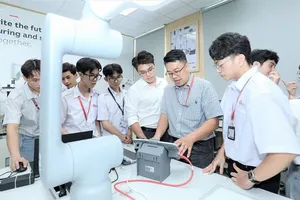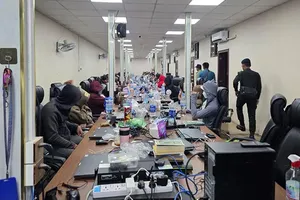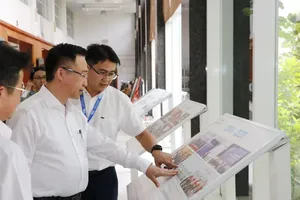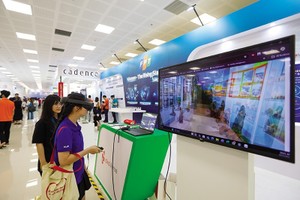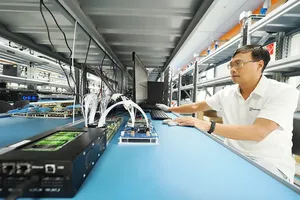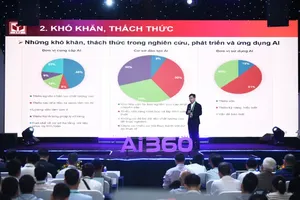
AI reshapes digital race
When it comes to development potential, Chief Technology Officer (CTO) of Viettel AI Nguyen Hoang Hung offered a candid assessment. Vietnam, he argued, can master AI technology, even though it’s currently facing a significant “infrastructure gap,” particularly in AI server systems, when compared to other nations.
In its strategic planning, the Government has reportedly set an ambitious goal to propel Vietnam into the leading group of countries in Southeast Asia and into the world’s top 50 by 2030. This isn’t just a government push; Vietnamese tech enterprises have also been investing heavily in AI, pouring resources into new data centers and the development of novel AI models.
It’s reported that the country now has hundreds of data centers, with Viettel alone operating 15 of them. These hubs are in a state of continuous expansion, with massive investments going into world-class GPU systems designed for AI processing, such as the Nvidia DGX SuperPOD, alongside hundreds of HGX H200/H100 servers.
This “colossal investment” isn’t just hardware; it’s the foundation for Viettel AI’s “Make in Vietnam” product ecosystem. Core technologies are already deployed, powering a virtual legal assistant, a data analysis solution for 80 percent of provinces, and an eKYC service processing “hundreds of millions of requests” annually.
CEO Le Hong Viet of FPT Smart Cloud notes the global AI race is “heating up.” AI is no longer a future story, he argued; its impact is quantifiable, with US$1 invested in GenAI yielding 3.7 times in efficiency. He proposed a 2025-2030 roadmap, “Building Sovereign AI,” to help Vietnam rise to lead the region. This strategy centers on the four pillars of people, digital infrastructure, products, and ecosystem. It has three phases:
- 2025: foundation and preparation;
- 2026-2027: deployment and expansion;
- 2028-2030: achieving regional leadership.
Alongside this powerful momentum from the private sector, state management agencies are also moving to finalize the legal framework. It’s expected that on November 19, as part of the 10th session, the 15th National Assembly will formally discuss the draft Law on AI.
Deputy Minister of Science and Technology Bui Hoang Phuong shared that the draft law is built on several core principles: being “human-centric”; ensuring safety and transparency; promoting inclusive and sustainable development; applying balanced and harmonious governance.
The ministry’s core position, he explained, is that managing AI’s development must be approached multi-dimensionally, striking a delicate balance between fostering innovation and protecting the rights of citizens and businesses.
Promoting self-reliance, resilience
The stakes are high. Forecasts suggest AI could contribute a staggering $15.7 trillion to the global GDP by 2030. According to the WIN World AI Index 2025, Vietnam is actually well-positioned, currently ranking 6th out of 40 nations with a score of 59.2 out of 100 on its “AI readiness” level. Domestically, AI is seen as a key sector, with projections indicating it will have contributed around $80 billion, equivalent to 12 percent of the nation’s GDP, by 2030, if it can be widely adopted.
The potential is massive, but so is the risk. Warnings have already been sounded about the danger of technological dependency. In this new AI wave, a failure to achieve self-reliance, it’s argued, would leave Vietnam completely dependent on foreign-supplied core technology platforms, from chips and software to the foundational AI architecture. This, in turn, would directly impact the nation’s data security and could create a cascade of negative consequences.
In truth, the path to building sovereign AI is fraught with significant challenges. It’s not just about willpower; it’s heavily dependent on investment capital, technological capacity, and, of course, human resources.
Experts believe Vietnam faces technological disadvantages, suggesting it might take Vietnam another 20 years to catch up due to massive capital needs. They argue that sovereign AI must start with substantive AI applications and business models, becoming the goal for tech enterprises. Developing high-quality human resources is key to shorten the gap.
Minister of Science and Technology Nguyen Manh Hung affirmed AI is becoming a type of national infrastructure, just like electricity. He stated, “Whoever masters AI will have the superior advantage” in production, healthcare, education, and national governance.
It’s clear that in today’s volatile world, a nation is simply safer and stronger when it masters its own technology, especially AI. To get there, Vietnam must build its capacity for technological self-reliance and push forward with a clear and effective training strategy.
At the end of the day, mastering AI infrastructure and technology isn’t just a corporate goal. It’s a national strategy, one that’s intrinsically linked to educating the population on the spirit of self-reliance and resilience, and to gradually affirming the nation’s technological position on the world stage.
Deputy Director Vo Xuan Hoai of the National Innovation Center (NIC) informed that the Government is reportedly focusing on five key priorities:
- investing in national data centers and high-performance computing clusters to increase sovereignty, reduce latency, and ensure security;
- developing large-scale Vietnamese-language datasets for R&D;
- prioritizing AI human resources with a goal of training over 50,000 AI engineers by 2030;
- building a robust AI startup ecosystem;
- issuing supportive policies to create favorable conditions for AI enterprises, startups, and the workforce.



